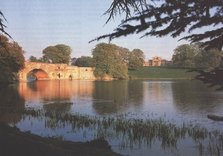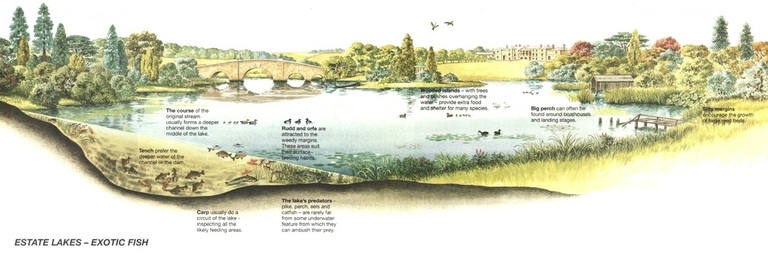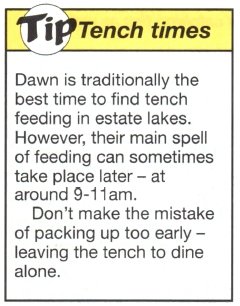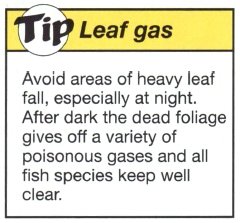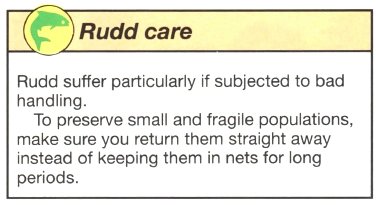Estate Lakes Statley Strategy
|
Many lakes were built in the grounds of great houses during the 18th century vogue for landscaping parklands.
Most were formed by damming a stream or spring in a valley overlooked by the house. Now around two hundred years old, some estate lakes are open to the general public for fishing on a day ticket basis - offering pleasant and challenging sport for anglers. |
Most still show signs of their original construction- important for the angler planning his fishing strategy. The lakes are often set in beautiful country surroundings and fine specimens can be taken from them. But they are difficult waters to fish and set a stern test of water craft skills.
Special features
The dam end of the lake usually holds the deepest water, generally 1.5 to 4.5m (5ft to 15ft) deep. The lake gradually shelves from the deep end towards the shallows, where the water can virtually dry up in the course of a long, hot summer.
Frequently the lake holds a deep central channel marking the course of the original stream. Although often only a trickle, it can become quite active after a summer storm.
Remains of the original ornamentation can sometimes still be seen -these include islands and parts of boathouses or landing stages.
The dam end of the lake usually holds the deepest water, generally 1.5 to 4.5m (5ft to 15ft) deep. The lake gradually shelves from the deep end towards the shallows, where the water can virtually dry up in the course of a long, hot summer.
Frequently the lake holds a deep central channel marking the course of the original stream. Although often only a trickle, it can become quite active after a summer storm.
Remains of the original ornamentation can sometimes still be seen -these include islands and parts of boathouses or landing stages.
|
Vision and vegetation
The springs keep the water clear, but the lakes can cloud up if there are high fish stocks, dense populations of wildfowl or rich algal growths. Luxuriant weed is unusual, but there can be extensive silting as a result of decades of leaves falling into the water - and never being removed. Large reed beds encroach around the margins and in the shallows, where the silting is most evident. |
|
What to expect
The species of fish present reflect the lake's history. Some fish were introduced because they were considered good for the table, so you'll find plenty of tench and bream. Rudd are often present because they were a very common species 200 years ago. Carp were popular then as now - the original fish stocks were fully scaled commons. Mirror carp in estate lakes were introduced after World War II. |
Pike, perch and eels may have stocked themselves - probably by entering through the original feeder streams. But other species present were certainly introduced during the late 19th century, when there was a great interest in natural history and a taste for introducing exotic species of plants and animals. Catfish, golden tench and orfe, often from Germany, are frequently found in estate lakes- survivors of the period.
Likely spots
Estate lakes can be anything from two to twenty acres in area. Their small size means fish can potentially be found in most parts of the lake. Nevertheless, different species favour distinct areas.
Tench prefer the deeper water along the dam and out in the central channel. But they feed happily in only 60cm (2ft) of water if the old bed is showing through the silt.
They are also found in the shallows when spawning, so don't fish for them at this time. They shun the shallows, however, once the sun gets high and hot, or if there is a cold wind.
Carp often use the same areas as tench but they are fond of the sun, basking in the shallows on hot afternoons. They are also great travellers and can make a tour of the whole lake between dusk and dawn. They search stems, fallen trees, exposed roots, boathouse brickwork and the rotting timbers of old landing stages. Their most favoured feeding areas are where the bottom is kept clear of mud and silt by springs or wind action.
Bream are roving fish and keep well away from the bank. They enjoy feeding in exposed areas of the lake where the wind whips up a bit of a ripple. You can spot them by the clouds of silt stirred up as they go down to feed.
Estate lakes can be anything from two to twenty acres in area. Their small size means fish can potentially be found in most parts of the lake. Nevertheless, different species favour distinct areas.
Tench prefer the deeper water along the dam and out in the central channel. But they feed happily in only 60cm (2ft) of water if the old bed is showing through the silt.
They are also found in the shallows when spawning, so don't fish for them at this time. They shun the shallows, however, once the sun gets high and hot, or if there is a cold wind.
Carp often use the same areas as tench but they are fond of the sun, basking in the shallows on hot afternoons. They are also great travellers and can make a tour of the whole lake between dusk and dawn. They search stems, fallen trees, exposed roots, boathouse brickwork and the rotting timbers of old landing stages. Their most favoured feeding areas are where the bottom is kept clear of mud and silt by springs or wind action.
Bream are roving fish and keep well away from the bank. They enjoy feeding in exposed areas of the lake where the wind whips up a bit of a ripple. You can spot them by the clouds of silt stirred up as they go down to feed.
|
Rudd, even more wary than bream, are found in the thickest weed beds, in impenetrable bays or deep among the lilies. Predatory fish such as pike, perch, eels and catfish make use of underwater ambush points in the lake. Islands, fallen trees, sunken boats, boathouse structures and the thickest weed beds generally harbour at least one predator.
|
Careful techniques
Approach the estate lake's clear waters carefully, using the most delicate gear within reason. As a guideline use a fairly powerful float rod and no less than 3-4lb (1.4-1.8kg) line for tench, and 2-3lb (0.9- 1.4kg) for bream. For carp you need a carp rod and 6-7lb (2.7-3.2kg) line.
These lakes are ideal for surface fishing and their shallow, warm waters encourage carp, rudd and even tench to feed off the top.
Natural baits seem to do the trick. A large, lively lobworm on a size 4 or 6 hook is hard to beat for most species present.
Freeline or float fish the lobworm in all the likely, snag-ridden areas. A small portion of the large, freshwater swan mussel can also be used -if you can find any.
Particle baits work extremely well in old waters like these. Corn, maggots, casters, hempseed and nuts are all fine choices.
Ideally you should have a pre-baiting programme. It may not be possible to put in three to four pints every day for a week before fishing. But if you can introduce some of your particles beforehand, the better your chances of catching will be.
Approach the estate lake's clear waters carefully, using the most delicate gear within reason. As a guideline use a fairly powerful float rod and no less than 3-4lb (1.4-1.8kg) line for tench, and 2-3lb (0.9- 1.4kg) for bream. For carp you need a carp rod and 6-7lb (2.7-3.2kg) line.
These lakes are ideal for surface fishing and their shallow, warm waters encourage carp, rudd and even tench to feed off the top.
Natural baits seem to do the trick. A large, lively lobworm on a size 4 or 6 hook is hard to beat for most species present.
Freeline or float fish the lobworm in all the likely, snag-ridden areas. A small portion of the large, freshwater swan mussel can also be used -if you can find any.
Particle baits work extremely well in old waters like these. Corn, maggots, casters, hempseed and nuts are all fine choices.
Ideally you should have a pre-baiting programme. It may not be possible to put in three to four pints every day for a week before fishing. But if you can introduce some of your particles beforehand, the better your chances of catching will be.

